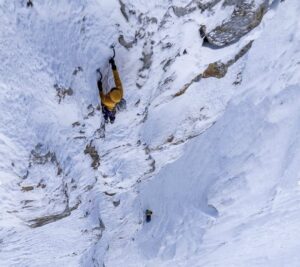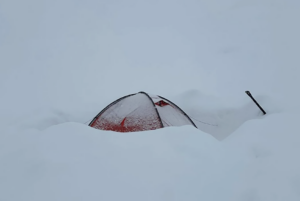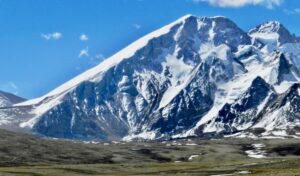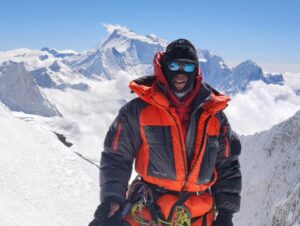Elisabeth Lardschneider, a young promising member of the Italian sport climbing team for the next Olympic Games, swapped the climbing gym this year for the remote valleys of India’s Himalaya. On her first experience in the Himalaya, she showed her true colors by climbing a new route on a granite big wall to a 5,600m unclimbed summit, together with Markus Ranalter. A new dimension of climbing was opening for her, but tragedy struck five days later: Lardschneider fell to her death on another peak. She was only 20 years old.
This is a story we never expected to write. Many cool climbs in isolated places pass unnoticed, and the same happens with a number of climbing accidents. Yet we hope the report of her first and last first ascent may be a sort of tribute.
Unclimbed spires
Earlier this fall, we reported on the first ascent of Jamyang Ri (5,800m), an impressive granite wall in Ladakh, India. Climbers Patrick Tirler and Moritz Sigmund were part of a larger Italian team, which spent most of July in Rangtik Topko, a side valley of Zanskar (Ladakh area).
According to Tirler, two members of the team did another, even harder first ascent. Elisabeth Lardschneider and Markus Ranalter succeeded on a line previously discarded by Tirler himself as too difficult.
“Only two lines seemed to be climbable through the 500m high, virgin northwest face of Small Jamyang Ri (5,600m),” Tirler wrote. “One of them turned out to be much too hard for us after three days of trying. The other also seemed impossible after the first attempts.
“But Lisi and Makke [Lardschneider and Ranalter] did not give up on their vision. They showed extreme determination and extraordinary skill, and finally managed to reach the crack that cuts through the whole wall up to the summit.”

Jamyang Ri and its secondary summit, seen from the valley. Photo: Stefan Plank
The climb
Lardschneider and Ranalter went for the Jamyiang Ri’s secondary summit (the one they call Small Jamyang Ri) not because it was the most difficult, but because it was the most accessible. Days of bad weather had covered the valley with fresh snow and increased the avalanche danger on most peaks. But this face was steep enough to shed the snow as soon as it fell.
“It was our first experience with a first ascent,” Ranalter admitted. “Choosing the steepest wall in a remote valley at the other end of the world at an altitude of over 5,000m sounds a bit ambitious.”
Yet the pair eyed a long crack that started around 100m up the face and snaked to the summit. The challenge was to reach that crack through the brittle rock of the lower sections.

Checking the face for possible lines. Photo: Stefan Plank
On their first attempt, they thought about giving up, but their partners encouraged them to try again.
“Without snow and clearer weather, the rock didn’t look that bad anymore,” they said. In fact, they made good progress. As they returned to base camp for the night (they climbed big-wall style, fixing pitches and retreating), they knew they wouldn’t surrender so easily a second time.

Elisabeth Lardschneider progresses up a dihedral section. Photo: Markus Ranalter
‘Overjoyed’
Finally, the pair took six days (with a couple of rest days in base camp) to summit the unclimbed wall. It included two nights on a portaledge — one on the way up and one on the way down. The pair reached Base Camp “overjoyed, with an indescribable sense of achievement.”
They climbed the 560m line in 18 pitches and graded it as VIII, A1 (X-?). “We call [the route] Nurbu Duk Lam, which means Special Valuable Line,” they wrote, after the very special moments they had lived during the climb.

Route topo. Photo: Elisabeth Lardschneider and Marus Ranalter
Markus Ranalter explained the rating to ExplorersWeb:
VIII (7a) is the obligatory difficulty that must be climbed in order to complete the sections that are not technically climbable. As we were not able to redpoint every pitch (all individual moves were climbed but not linked together), we just suggested a degree of difficulty for these lengths. This is why a question mark follows the difficulty degree of X- (8a). We noted A1 (aid climbing) for the 5th and 8th pitches, where we couldn’t climb all the moves.
First experience
Elisabeth Lardschneider and Markus Ranalter were not life partners, just a great climbing team. This was their first experience trying to open a new route and their first time at altitude. They didn’t have a clear plan about how to distribute the tasks when climbing, so they just let the climb flow.
“It was clear that Elisabeth was the better climber and I was better at technical things and rope handling,” Ranalter told ExplorersWeb. “Most of the time, however, we simply alternated after each rope length and we also took turns on the difficult lengths.”

The climbers in the portaledge. Photo: Markus Ranalter
There is a detailed account of the climb on the South Tyrol Alpine Club‘s website. Oddly, there is no mention of what happened next, and the climbers consulted by Explorersweb said nothing either until a reader pointed it out to us when we briefly published an earlier version of this story.
When we asked for confirmation, the climbers confirmed the sad facts. “The accident happened on July 26,” Ranalter said. “She slipped on the snow/icefield of Chanrasrik Ri and fell 100 to 150m. She died instantly. it was an indescribably sad moment…We all still can’t believe it.”
Elisabeth Lardschneider of Ortisei (near Val Gardena) was one of the most promising sports climbers in Italy. She was a high-level athlete since she sent her first 8b at 14 years old. A member of the National Sport Climbing team, she was going to participate in the Paris 2024 Olympics.
Last year, she also acquired experience on higher peaks by climbing the west face of Pik Odessa (4,810m) in Kyrgyzstan. She dreamed of eventually becoming a mountain guide and rescuer at her home in the South Tyrolean Dolomites.






